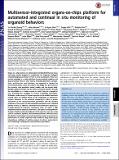Multisensor-integrated organs-on-chips platform for automated and continual in situ monitoring of organoid behaviors
Author(s)
Zhang, Yu Shrike; Aleman, Julio; Shin, Su Ryon; Kilic, Tugba; Kim, Duckjin; Mousavi Shaegh, Seyed Ali; Massa, Solange; Riahi, Reza; Chae, Sukyoung; Hu, Ning; Avci, Huseyin; Silvestri, Antonia; Sanati Nezhad, Amir; Manbohi, Ahmad; De Ferrari, Fabio; Polini, Alessandro; Calzone, Giovanni; Shaikh, Noor; Alerasool, Parissa; Budina, Erica; Kang, Jian; Bhise, Nupura; Ribas, João; Pourmand, Adel; Skardal, Aleksander; Shupe, Thomas; Bishop, Colin E.; Dokmeci, Mehmet Remzi; Atala, Anthony; Zhang, Weijia; Khademhosseini, Ali; ... Show more Show less
DownloadZhang-2017-Multisensor-integrated organs-on-ch.pdf (2.055Mb)
PUBLISHER_POLICY
Publisher Policy
Article is made available in accordance with the publisher's policy and may be subject to US copyright law. Please refer to the publisher's site for terms of use.
Terms of use
Metadata
Show full item recordAbstract
Organ-on-a-chip systems areminiaturizedmicrofluidic 3D human tissue and organ models designed to recapitulate the important biological and physiological parameters of their in vivo counterparts. They have recently emerged as a viable platform for personalized medicine and drug screening. These in vitro models, featuring biomimetic compositions, architectures, and functions, are expected to replace the conventional planar, static cell cultures and bridge the gap between the currently used preclinical animal models and the human body. Multiple organoid models may be further connected together through the microfluidics in a similar manner in which they are arranged in vivo, providing the capability to analyze multiorgan interactions. Although a wide variety of human organ-on-a-chip models have been created, there are limited efforts on the integration of multisensor systems. However, in situ continual measuring is critical in precise assessment of the microenvironment parameters and the dynamic responses of the organs to pharmaceutical compounds over extended periods of time. In addition, automated and noninvasive capability is strongly desired for long-term monitoring. Here, we report a fully integrated modular physical, biochemical, and optical sensing platform through a fluidics-routing breadboard, which operates organ-on-a-chip units in a continual, dynamic, and automated manner.We believe that this platform technology has paved a potential avenue to promote the performance of current organ-on-a-chip models in drug screening by integrating a multitude of real-time sensors to achieve automated in situ monitoring of biophysical and biochemical parameters.
Date issued
2017-03Department
Harvard University--MIT Division of Health Sciences and Technology; Koch Institute for Integrative Cancer Research at MITJournal
Proceedings of the National Academy of Sciences
Publisher
National Academy of Sciences (U.S.)
Citation
Zhang, Yu Shrike, et al. “Multisensor-Integrated Organs-on-Chips Platform for Automated and Continual in Situ Monitoring of Organoid Behaviors.” Proceedings of the National Academy of Sciences 114, 12 (March 2017): E2293–E2302 © 2017 National Academy of Sciences
Version: Final published version
ISSN
0027-8424
1091-6490